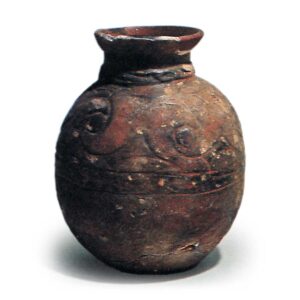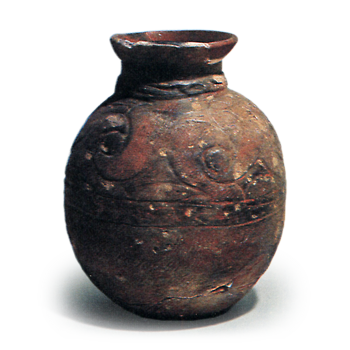
A general term for Late Jomon-style earthenware from the Tohoku region. The name was given to the earthenware from the Kameoka site in Nishi-tsugaru Kizuki-cho, Aomori Prefecture. A study of the earthenware from the Ohdora shell mound in Ofunato City, Iwate Prefecture, led to the subdivision of the pottery into six types (Ohdora B, B-CC1, C2, A, and A’), but more recently there has been some thought of dividing it into nine types, while others consider it to be five types.
The majority of Oka-style earthenware is a coarse deep bowl. The thick earthenware is made of sand mixed with clay, and is decorated with simple designs and jomon patterns.
On the other hand, refined earthenware is thin and made of dense clay, generally small in size, and includes dozens of different types of bowls, plates, jars, high cups, and incense burners. These refined earthenware vessels have a blackish-black color and are decorated with ornately carved wood carvings and patterns. The number of types of vessels and the variety of patterns are greatest in the older stages, while in the newer stages, the number of types of vessels and the variety of patterns decrease. In the older stages, curved patterns were developed, such as Y-shape combinations (called triclinic patterns) and S- and K-shape combinations (called triclinic patterns), and the delicate abrasive rope patterns were used to great effect. However, the patterns gradually shifted to parallel lines, and the Jomon pattern was replaced by the Koji pattern, and the Jomon pattern disappeared. Some pieces are also decorated with tansai (red lacquer), others with lacquer mixed with tan on a black lacquer ground, and still others with red lacquer. The patterns on Kamegaoka earthenware show a regular pattern for each type of vessel and each part of the vessel (mouth rim, neck, body, base, etc.), and this pattern has been passed on genealogically according to the changes in the age of the vessel. The existence of an unusually large number of types of vessels and complex patterns in the Kamegaoka style has been interpreted as a result of regulations and prohibitions, such as the use of certain items at certain times and for certain purposes, even for boiling and serving the same food, and the clear distinction between these items. Refined Kamegaoka-style earthenware exists in the Tohoku region and southern Hokkaido with some local color, and was also brought to the Kanto, Chubu, and Kinki regions, where it coexists with local earthenware. This proves that the end of the Jomon period did not differ greatly in age throughout the country.



